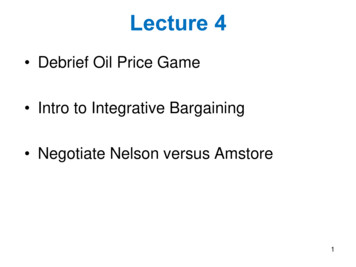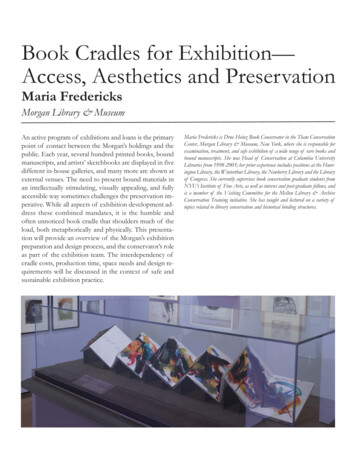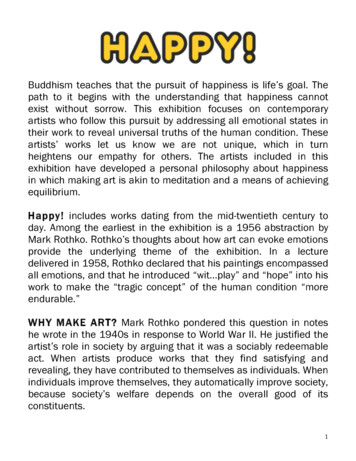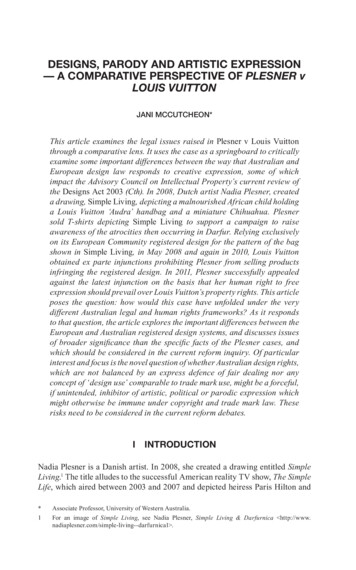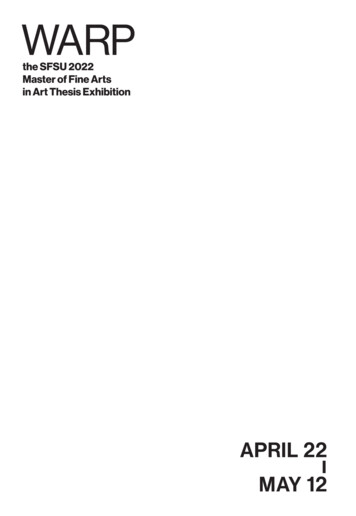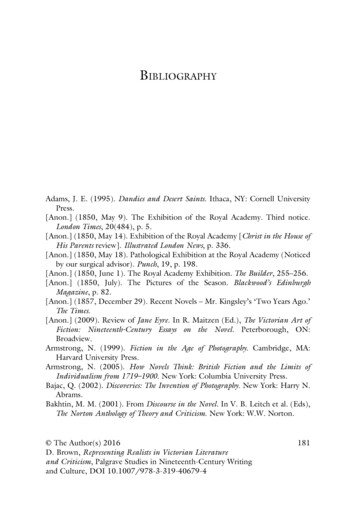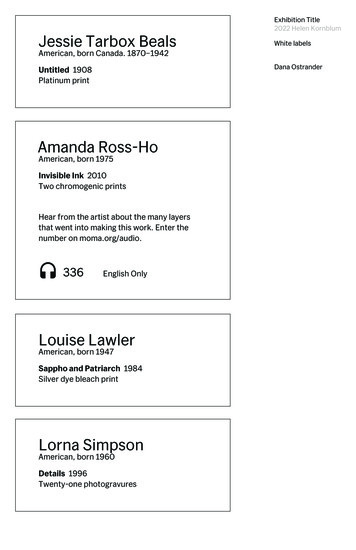
Transcription
Jessie Tarbox BealsExhibition Title2022 Helen KornblumWhite labelsAmerican, born Canada. 1870–1942Dana OstranderUntitled 1908Platinum printAmanda Ross-HoAmerican, born 1975Invisible Ink 2010Two chromogenic printsHear from the artist about the many layersthat went into making this work. Enter thenumber on moma.org/audio.336English OnlyLouise LawlerAmerican, born 1947Sappho and Patriarch 1984Silver dye bleach printLorna SimpsonAmerican, born 1960Details 1996Twenty-one photogravures
Silvia KolbowskiExhibition Title2022 Helen KornblumWhite labelsArgentine, born 1953Model Pleasure III 1983Eight gelatin silver prints and fourchromogenic color prints, originally in blackartist framesAcquired through the generosity of HelenKornblum in honor of Roxana Marcoci andCommittee on Photography Fund, 2014Ruth OrkinAmerican, 1921–1985American Girl in Italy 1951Gelatin silver printLaurie SimmonsAmerican, born 1949Three Red Petit-Fours 1990Chromogenic printRuth OrkinAmerican, 1921–1985Jimmy the Storyteller 1947Six gelatin silver printsDana Ostrander
Frances BenjaminJohnstonAmerican, 1864–1952Penmanship Class 1899Platinum printJeanne DunningAmerican, born 1960Leaking 1994Two silver dye bleach prints (diptych)Sharon LockhartAmerican, born 1964Untitled 2010Chromogenic printJosephine PrydeBritish, born 1967Far Horizons Draw No Nearer IV 2002Gelatin silver printExhibition Title2022 Helen KornblumWhite labelsDana Ostrander
Lola Álvarez BravoExhibition Title2022 Helen KornblumWhite labelsMexican, 1907–1993Frida Kahlo c. 1945Gelatin silver printCarrie Mae WeemsAmerican, born 1953Untitled (Woman and daughter withmakeup), from The Kitchen Table Series1990Gelatin silver printHear from the artist about the intertwinedthemes of race, love, and power in herKitchen Table Series. Enter the number onmoma.org/audio.338English OnlyDana Ostrander
Catherine OpieExhibition Title2022 Helen KornblumWhite labelsAmerican, born 1961Angela Scheirl 1993Chromogenic printTracey MoffattAustralian, born 1960Up in the Sky 1997Offset lithographCandida HöferGerman, born 1944Deutsche Bucherei Leipzig IX (GermanNational Library in Leipzig IX) 1997Chromogenic printIn this work Lawler set her viewfinder ontwo sculptures in a darkened gallery atthe Wadsworth Atheneum in Hartford,Connecticut. In the resulting image atowering Sappho is overshadowed bothliterally and figuratively by the stern andspotlighted bust of a male elder in thebackground. Through her careful framing,Lawler reveals how museum display canreinforce inequalities, even inadvertently,and invites us to reevaluate the art institutionas a space in which identities and genderroles are in play—a space of ongoingideological construction.Dana Ostrander
Susan MeiselasExhibition Title2022 Helen KornblumWhite labelsAmerican, born 1948Dana OstranderTOP:Traditional Mask Used in the PopularInsurrection, Monimbo, Nicaragua 1978BOTTOM:A Funeral Procession in Jinotepe forAssassinated Student Leaders.Demonstrators Carry a Photograph ofArlen Siu, an FSLN Guerrilla Fighter Killed inthe Mountains Three Years Earlier 1978Chromogenic printsCara RomeroNative American (Chemehuevi), born 1977Wakeah, from the series First American Girl2018Inkjet printJoin the artist in looking closely at thisphotograph and its message ofempowerment. Enter the number onmoma.org/audio.337English Only
Hulleah J.TsinhnahjinnieNative American (Seminole-Muscogee-Diné[Navajo]), born 1954Vanna Brown, Azteca Style 1990Photocollage, printed 2021Discover how this artwork holds a mirror upto society. Enter the number onmoma.org/audio.334English OnlyBarbara ProbstGerman, born 1964Exposure #78, NYC, Collister and HubertSt., 06.22.10, 7:56 p.m. 2010Two inkjet prints (diptych)Learn more from the artist about therelationship between these two images. Enterthe number on moma.org/audio.339English OnlyExhibition Title2022 Helen KornblumWhite labelsDana Ostrander
Meridel RubensteinExhibition Title2022 Helen KornblumWhite labelsAmerican, born 1948Dana OstranderTOP:Fatman with Edith 1993Helen Kornblum explores the ways war andweaponry inform this photo. Enter thenumber on moma.org/audio.BOTTOM:Penitente 1982Palladium prints340English Only“Dance photography,” German photographerRudolph wrote in 1929, is “the representationof the movement of the dancer in pictureform, that means the dancer dances duringthe shooting.” To capture the spirit of dancein a still frame, she contended, thephotographer must imagine herself as theperformer, anticipating the flow of motion.Rudolph and other interwar photographerssought inventive ways to picture the freedomof moving bodies and affirm the expressiveagency of women. Through engaging withdance as a reflection of society and culture,these photographs advance different utopianand progressive models of community.
Exhibition Title2022 Helen KornblumIn the 1980s and early 1990s, many artistsexplored the interrelated histories ofcolonialism and patriarchy in Latin America.Through what she called “emotiveanthropology,” Yampolsky engaged directlywith the lives of Indigenous Mazahua womenin the State of Mexico rather than simplysnapping photographs; similarly, Garduño’sintimate portraiture meditates on theadaptations of ancient cultural rituals incontemporary life, with the figures of womenof Indigenous heritage at the center. Ritualwas central to Mendieta’s practice, too: sheincorporated Mesoamerican goddessarchetypes into photographicallydocumented performances that shedescribed as “a dialogue between thelandscape and the female body.”To create the works in her Exposures series,Probst used radio-wave transmission tosimultaneously release the shutters ofmultiple cameras and thus capture a singlescene from different distances andperspectives. The resulting images challengethe idea that a photograph presents anobjective view of reality. “The substance ofthe series,” Probst has said, “exists not in theindividual image, but rather in theinterrelations between the images. . . . Theviewer is invited to travel through the spacethey mark out, to take on different points ofview and to see [themself] looking.”White labelsDana Ostrander
Exhibition Title2022 Helen KornblumThroughout the twentieth century,photographers transformed perceptions ofthe natural world through different kinds ofphotographic technology and techniques.Cunningham, Noskowiak, and Lavenson, allmembers of the California-based Group f/64,used stark lighting and close-up framing torender the patterns and textures of botanicalforms. Bernhard photographed seashells,discovering, as she put it, “forms so complexand weird as to exceed human imagination,”while Morgan superimposed images tosuggest what she called the “invisible urges”underlying the life cycles of plants.Opie has noted of her intimate portraits that“even though I don’t believe that there is atrue essence of a person, I do believe there issomething that they see within themselvesthat I end up capturing.” Here, Angela Scheirl,a filmmaker and part of Opie’s LGBTQcommunity, sports a navy blue suit and shorthair and has a commanding gaze. Scheirleventually took the first name Hans, leavingthe work’s title outdated but alsoemphasizing the flexibility of genderexpression and its mutability over time.Unlike a traditional portrait, which fixes orfreezes identity, this is a portrait of becoming.White labelsDana Ostrander
Exhibition Title2022 Helen KornblumIn this image, one of twenty in Weems’sKitchen Table Series, the artist sits at thehead of a table, applying makeup with thehelp of a small vanity mirror. Next to her, ayoung girl looking at her own reflection putson lipstick in a parallel gesture. The tenderscene illustrates one of the ways in whichgender is learned and performed, while alsocelebrating the private subjectivity, beauty,and inner lives of Black women. Asked whyshe appears as a protagonist in her work,Weems responded, “I use myself simply as avehicle for approaching the question ofpower.”Romero’s First American Girl series—whosetitle nods to the popular doll brand—countersovergeneralized pop-culture representationsof Native Americans with authentic detail.Wakeah shows Wakeah Jhane, a ComancheBlackfeet-Kiowa ledger artist and dancer,wearing buckskin dance regalia that assertsthe specificity of her Native culture, theartistry of regional handicraft traditions, andthe creative power of Native women. Theimage’s diorama-style arrangement evokesthe ways in which photography has presentedIndigenous people as anthropologicalspecimens. Romero, a citizen of theChemehuevi Indian Tribe, shows the vibrancyof contemporary Indigenous lives, in contrastto the colonial narratives that have becomeall too familiar.White labelsDana Ostrander
Exhibition Title2022 Helen KornblumWhat appears to be a serene domesticinterior—the artist’s niece working on a jigsawpuzzle— contains allusions to darkerhistories. Hanging on the wall is a colonial-eramap of the Maine coastline, and the puzzlereproduces a painting by Winslow Homer,whose iconic seascapes portrayed NewEngland as an idyllic land “discovered” byhardy explorers. Homer’s work did notacknowledge the deadly wars fought over theterritory, nor the near annihilation of theWabanaki people, the region’s Indigenousinhabitants. With these subtle and uneasycues, Lockhart demonstrates the ways inwhich the comforts of home can be built onunseen histories of territorial expansion andforced relocation.“It was a beautiful day when I decided that Iwould take responsibility to reinterpretimages of Native peoples,” Tsinhnahjinnie, aSeminole-Muscogee-Diné (Navajo) artist, hassaid. In Vanna Brown, Azteca Style, she haswittily recast Wheel of Fortune game-showstar Vanna White as an Indigenous woman, asatirical choice that highlights the invisibilityof Native Americans in the mass media andthe stereotypes that are routinely employedwhen they do appear. In contradicting thesefictions, which are rooted in America’scolonial history, her work claims visualsovereignty and self-determination forIndigenous people—the right to decide howthey are represented.White labelsDana Ostrander
Exhibition Title2022 Helen KornblumContemporary photographers seeking torecord political and economic hardshipsoften found a model in documentaryphotographs from the 1930s and ’40s. WhenNoggle organized her groundbreakingexhibition Women of Photography in 1975,she selected Dorr’s Depression-eraphotographs for inclusion. Noggle’s stagedportraits of retired women Air Force pilots,made during the 1980s, were likely inspiredby Dorr’s intimate, carefully composedportraits of friends (on view in the vitrine).Similarly, Mark’s images of impoverishedyouth, such as Tiny, a homeless sex worker inSeattle, are patterned on Bourke-White’spowerful yet sensitive images ofdisenfranchised workers.Meiselas’s photographs reveal a nation inturmoil. Taken in Nicaragua in 1978, shortlybefore the revolt of the socialist SandinistaNational Liberation Front (FSLN) ended thebrutal forty-year authoritarian rule of theSomoza family, they trace the evolution of apopular resistance among student groupsand indigenous communities. Meiselas, oneof the few photojournalists documenting theconflict, mostly used color film for theseimages. She later reflected that “the vibrancyand optimism of the resistance, as well as thephysical feel of the place, came throughbetter in color.”White labelsDana Ostrander
Germaine KrullDutch, born Germany. 1897–1985Photographs in “Nudisme,” special issue,Jazz: L’actualité intellectuelle (1931)Editor: Carlo RimPublisher: Louis Querelle, ParisGift of Helen Kornblum in honor of RoxanaMarcoci, 2020. The Museum of Modern ArtLibrary, New YorkSilvia KolbowskiArgentine, born 1953Photographs in Difference: OnRepresentation and Sexuality, by KateLinker 1984Publisher: The New Museum ofContemporary Art, New YorkThe Museum of Modern Art Library, New YorkMeridel RubensteinAmerican, born 1948Ellen ZweigAmerican, born 1947Critical Mass 1993Publisher: The Museum of Fine Arts, Museumof New MexicoThe Museum of Modern Art Library, New YorkLaura GilpinAmerican, 1881–1979The Enduring Navaho 1968Publisher: University of Texas Press, AustinThe Museum of Modern Art Library, New YorkExhibition Title2022 Helen KornblumWhite labelsDana Ostrander
Susan MeiselasAmerican, born 1948Nicaragua, June 1978–July 1979 1981Publisher: Pantheon Books, New YorkThe Museum of Modern Art Library, New YorkNell DorrAmerican, 1893–1988Mother and Child 1954Publisher: Harper & Brothers, New Yorkand LondonThe Museum of Modern Art Library, New YorkMargaret Bourke-WhiteAmerican, 1904–1971You Have Seen Their Faces, with text byErskine Caldwell 1937Publisher: Modern Age Books, New YorkThe Museum of Modern Art Library, New YorkRuth OrkinAmerican, 1921–1985Jimmy Tells About Kitty and the Kingphotographs in LIFE, vol. 31, no. 22(November 26, 1951)Publisher: Time, Inc., New YorkGift of Helen Kornblum in honor of RoxanaMarcoci, 2020. The Museum of Modern ArtLibrary, New YorkExhibition Title2022 Helen KornblumWhite labelsDana Ostrander
Imogen CunninghamExhibition Title2022 Helen KornblumAmerican, 1883–1976White labelsPhotograph in Catalogue for the CornishSchool c. 1935Dana OstranderPublisher: The Cornish School, SeattleGift of Helen Kornblum in honor of RoxanaMarcoci, 2020. The Museum of Modern ArtLibrary, New YorkMariana YampolskyMexican, born United States. 1925–2002Mazahua 1993Publisher: Instituto Mexiquense de Cultura,Gobierno del Estado de México, TolucaThe Museum of Modern Art Library, New YorkSusan MeiselasAmerican, born 1948Carnival Strippers 1976Publisher: Farrar, Straus and Giroux,New YorkThe Museum of Modern Art Library, New YorkHear an excerpt from Carnival Strippers.Enter the number on moma.org/audio.341English OnlyImogen CunninghamAmerican, 1883–1976Three Harps 1935Gelatin silver print
Lotte JacobiExhibition Title2022 Helen KornblumAmerican, born Germany. 1896–1990White labelsUrsula Johanna RichterDana OstranderGerman, 1886–1946Charlotte RudolphGerman, 1896–1983Photographs in Der künstlerische Tanz (TheArtistic Dance) c. 1934Publisher: Haus Neuerburg GmbH, Merzig,GermanyGift of Helen Kornblum in honor of RoxanaMarcoci, 2020. The Museum of Modern ArtLibrary, New YorkSusan MeiselasAmerican, born 1948Tentful of Marks, Tunbridge, Vermont, fromthe series Carnival Strippers 1974Gelatin silver print, printed c. 2000The artist reflects on the intersectionsof feminism, performance, and personalidentity. Enter the number onmoma.org/audio.335English OnlyLaura GilpinAmerican, 1881–1979Navajo Weaver 1933Platinum print
Yva (Else Ernestine Neuländer)German, 1900–1942Photographs in Gebrauchsgraphik:Monatschrift zur Förderung künstlerischerReklame (International Advertising Art:Monthly Magazine for Promoting Art inAdvertising), vol. 8, no. 11 (November 1931)Editor: H. K. FrenzelPublisher: Phönix Illustrationsdruck undVerlag, BerlinGift of Helen Kornblum in honor of RoxanaMarcoci, 2020. The Museum of Modern ArtLibrary, New YorkRuth BernhardAmerican, born Germany. 1905–2006Photographs in The Studio, vol. 137, no. 674(May 1949)Publisher: National Magazine Co., LondonThe Museum of Modern Art Library, New YorkMargaret WatkinsCanadian, 1884–1969Untitled (Still Life with Mirrors andWindows, NYC) 1927Gelatin silver printMargaret WatkinsCanadian, 1884–1969Photographs in House & Garden, vol. 52, no.3 (September 1927)Publisher: Condé Nast Publications, New YorkExhibition Title2022 Helen KornblumWhite labelsDana Ostrander
Imogen CunninghamExhibition Title2022 Helen KornblumAmerican, 1883–1976White labelsPhotograph in Catalogue for the CornishSchool c. 1935Dana OstranderPublisher: The Cornish School, SeattleGift of Helen Kornblum in honor of RoxanaMarcoci, 2020. The Museum of Modern ArtLibrary, New YorkPhotojournalism provided a vital source ofincome for women photographers whoworked in a documentary mode. In 1937Bourke-White, a staff photographer forpublications Fortune and LIFE, made a visualsurvey of rural communities in theDepression-era American South. Orkin’sseries on a young storyteller named Jimmybrought her national attention. Afterappearing in Look and LIFE magazines, it wasselected for inclusion in MoMA’s 1955exhibition The Family of Man. Contemporaryphotographers such as Meiselas, a member ofthe Magnum Photos cooperative, haveexpanded the possibilities of photojournalismthrough personal investment in thecommunities and events they document.By the 1930s, the nature of women’s workhad been shifting for decades, from domesticto commercial labor. Gilpin’s images of Diné(Navajo) women weaving textiles for thetourist market were made at a time whenprofessional employment in photography hadonly recently been opened to women. Somewomen started businesses during the 1940s,including Edith Warner, shown inRubenstein’s contemporary photographs,who ran a tearoom in New Mexico for bothIndigenous clientele and the scientistsdeveloping the atom bomb nearby. In manyaffluent families, however, childcareremained a woman’s primary responsibility,as is depicted in Mother and Child, Dorr’sbook of portraits.
In the rapidly transforming publishingecosystem of the 1920s and ’30s, modernistphotographers portrayed the female figure innew and different ways. Krull’s nudes andhand studies, reproduced in Jazz magazine,frame poses and gestures as a kind ofperformance. Rudolph’s and Jacobi’spictures of the dancer Greta Palucca, widelycirculated in magazines and books, capture asense of physical freedom. Cunninghamconveyed the visual rhythm of a harpist’sstrumming hands through triple exposure.Bernhard transformed seashells intoanatomical forms through diffuse, ethereallighting effects. Techniques such asfragmentation, movement, light, and collage,made nontraditional representations offemininity possible.Between the World Wars, photographerscreated new consumer desires throughimages for the illustrated press, such as Yva’salluring fashion studies that modeled theedgy modern sensibility of the New Woman.The media’s use of the female figure was alsoserious subject for critique. In a 1930counter-memoir, Cahun explored modes ofself-presentation that defied the massmedia’s typical depiction of women as figuresmerely meant to catch the eye of maleviewers. In the 1970s and 1980s, Conceptualartists such as Silvia Kolbowski continued tochallenge the clichés of “ideal,” pleasureproducing femininity, combining, as Cahundid, image and text.Exhibition Title2022 Helen KornblumWhite labelsDana Ostrander
Claude Cahun (Lucy Schwob)French, 1894–1954Marcel Moore (Suzanne Malherbe)French, 1892–1972Aveux non avenus (Disavowels or CancelledConfessions) 1930Illustrated book with photogravuresPublisher: Éditions du Carrefour, ParisThe Museum of Modern Art Library, New YorkRuth BernhardAmerican, born Germany. 1905–2006Photographs in The Studio, vol. 137, no. 674(May 1949)Publisher: National Magazine Co., LondonThe Museum of Modern Art Library, New YorkExhibition Title2022 Helen KornblumWhite labelsDana Ostrander
artistry of regional handicraft traditions, and the creative power of Native women. The image's diorama-style arrangement evokes the ways in which photography has presented Indigenous people as anthropological specimens. Romero, a citizen of the Chemehuevi Indian Tribe, shows the vibrancy of contemporary Indigenous lives, in contrast
